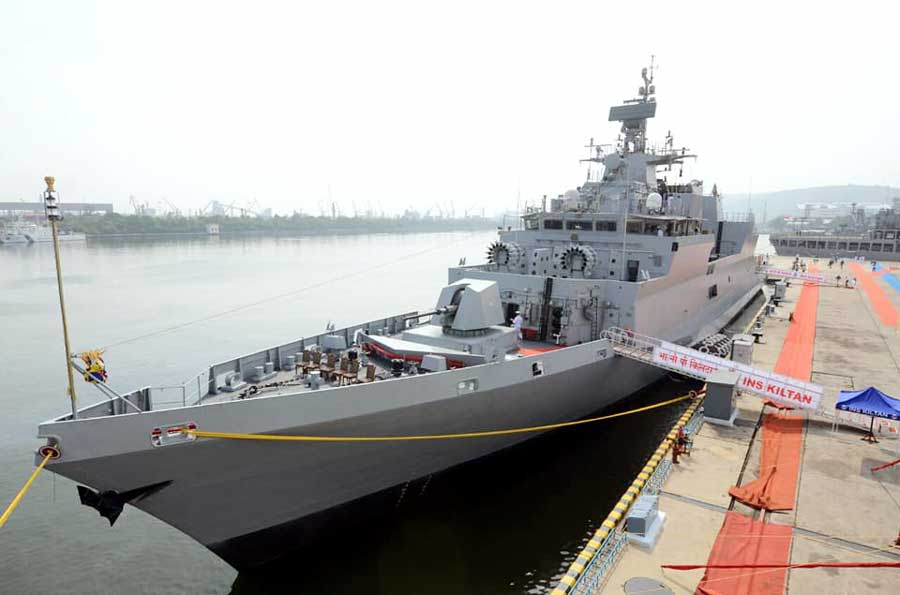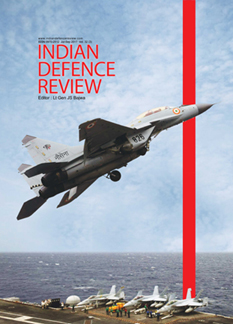The spectre of obsolescence and rapidly changing technology, especially the advent of unmanned vehicles will drive the future trends of NCS. Open Architecture and Cyber Security will take centre stage. Aspects of inter-operability, commercially viable substitutes and budgetary constraints will also play a significant role. All in all interesting times are ahead in the continuing development of Naval Combat Systems; we may see smart phones, in the not so distant future being used in Combat Operations Management.
Surface warfare ships were heavier with heavier six inch guns and some air defence capability in four inch guns; these ships had virtually no ASW capability…
Naval warfare has always been and will be unique and distinct from the other two viz land and air. This is simply because of the medium in which it is conducted and also has the necessity and ability to influence the warfare in the other two dimensions. The weapons platform in the maritime domain experiences far more dynamic conditions as compared to the other two mediums which make the resolution of the problems in effective delivery of the ordnance much more complex. This is just stating the obvious. The solutions call for intricate and complex mathematical and trigonometric applications. Before the advent of computer science and electronics, the mariner relied on pre-computed tables giving solutions.
The problem gets even more compounded in the undersea dimension where submarines operate. The two dimensional approach changes to a three dimensional one with attendant complexities of axis stabilisation.
In essence, the problem is of delivering the ordnance on the target whether stationary or mobile, with accuracy using available inputs. This implies solving the basic problems by Inputs (Surveillance) – Processing (Computation of Data & Weapon) – Delivery (Weapon System). Let us dwell on this:
• Surveillance. This is the starting step for any action towards neutralisation of threat. This process could be by way of visual means, radar, sonar, satellites, drones, Electronic Support Measures (ESM) and communication (direction finding). The objective is to detect the threat and transmit the data of target coordinates to the processing system.
• Processing Systems. The data on target coordinates and its motion needs to be processed to assess the value of threat and choosing a weapon system to neutralise it. This could be by mathematical tables, by stand-alone computer systems analogous/digital to work out the solution for delivering the ordnance from the chosen weapon system.
The onset of the electronic revolution and consequently, miniaturisation brought in a phase of immense change in the design of warships and for sensors, information processing and weapon systems…
• Delivery. This comprises the weapon delivery system be it a gun, torpedo, missile or decoy to engage the threat. A system could be a decentralised fire control system controlling only its integral ordnance delivery mechanism or it could be a part of an integrated combat system managing the ordnance delivery of a number of systems constituting the combat system.
• The sequence of events in the above three is surveillance, detection, classification, identification, tracking, indication (to the processing system), processing the solution, direction (to the FCS/Director), refining the solution and engagement. Usually this could be a closed or open architecture depending on the sophistication of the technology.
Simple as this may appear, it is a complex process depending on the nature of surveillance, sensors, nature of target, processing hardware, weapons system and delivery mechanisms and target parameters. Consequently, the Naval Fire Control Systems have evolved over a period of time in consonance with the sophistication of the technological environment. Accordingly, this paper attempts to portray the evolution of Naval Combat Systems and is restricted to general principles and concepts without detailing specific systems, as those by themselves constitute separate studies.
Historical Background
In pre- and post- WW II, the design philosophy of warships was mainly centered on countering a perceived threat with a weapons system and building the platform around that system. It was for this reason, that we had specialised platforms such as Air Defence (AD) Frigates, Anti-Submarine Warfare (ASW) Frigates and Anti-Surface (ASU) Warfare Ships. For example, there were Whitby Class Frigates which were ASW Frigates, Leopard Class Frigates, which were Air Defence Frigates, Blackwood Class Frigates which were purely ASW Frigates. The template of the Royal Navy is being used here, as during those times, it was the most powerful and evolved maritime force. Even in smaller Corvettes, this philosophy was followed.
The arrival of ship-launched, anti-ship cruise missiles and anti-aircraft missiles added a totally new dimensional capability to ship designs…
Fire Control Systems (FCS)
Consequently, the primary weapon systems were meant for those functions and these systems were mainly stand alone and decentralised ones on the ship, having their own dedicated Fire Control Systems. This arrangement allowed for greater focus and accuracy of such fire control systems to counter the threat against which they were designed. Surface warfare ships were heavier, such as the colony class cruisers with heavier six inch guns and some air defence capability in four inch guns. These ships had virtually no ASW capability. These systems were more reliant on electronic valve-based analogous systems and magnetic amplifiers, which were bulky and occupied large volumes of space on the ship. Although such arrangement provided for a more focused and efficient way to counter a threat, it was an expensive one and led to multiplicity of platforms in the composition of a maritime force.
Electronic Revolution: Developments Post WW II
The onset of the electronic revolution and consequently, miniaturisation brought in a phase of immense change in not only the design of warships but also for sensors, information processing and weapon systems. The energy requirements for operation of such systems saw a sharp drop, the capacity and volume of information management saw a quantum leap, which permitted multiple weapon systems to be accommodated on a single platform, thereby giving rise to general purpose ships. It became possible to design ships with multiple capabilities wherein all major capabilities such as ASU, ASW, AD (indeed – AAW- Anti Air Warfare) could be incorporated on a single platform. Leander Class Frigates was such a design in the Royal Navy, Spruance class followed by the Arleigh Burke in the US Navy and Kashin Class in the Russian Navy. These were multi mission capable ships.
Onset of Anti-ship and Anti-Air Ship launched missiles.
The arrival of ship-launched, anti-ship cruise missiles and anti-aircraft missiles added a totally new dimensional capability to ship designs, integral to which is the evolution of Naval Combat Systems.
Appearance of Ship-Borne Helicopter
Another significant development post- WW II was the appearance of ship-borne helicopters. These added an entirely new horizon to ship design and extended the capability against threats, especially in anti-submarine warfare. An ASW Helicopter with its dunking sonar and anti-submarines torpedo/depth charge delivery capability gave an extended reach to a ship against a submarine.
The first step to a modern Naval Combat System was the concept of Computer Aided Action Information System (CAAIS)…
Multi-Function Radars and Consoles
In similar fashion, multi-function radars with track-while-scan capabilities, phased array antennae also opened up newer vistas in a platform’s surveillance capability. Finally, advances in information processing capability in the form of first/second generation computers linked to multi-function consoles enabled processing of the information in quick time in order to counter, air, submarine and surface warfare threats, against which reaction time had been shortened considerably.
Computer Aided Action Information Systems.
The first step to a modern Naval Combat System was the concept of Computer Aided Action Information System (CAAIS). However, even at this stage, a CAAIS was a centralised fire control system and not a modern Naval Combat System. The CAAIS was still a central processor of information given from the sensors such as radars, sonars, ESM systems and work out the motion parameters of the threat and generate the coordinates to be fed to the concerned FCS/weapons system to effectively liquidate that threat. Working regimes to manage the combat readiness such as Command, Control, Communication and Intelligence (C3I) systems which had been in force gave rise to a new regime C⁴I in which in addition to the existing Cs, the fourth signified Computers, came into vogue. The collection and processing of the entire spectrum of the information from sensors could be managed with greater accuracy, speed and integrity in order to direct the weapon systems to execute assigned tasks.
In this initial stage, the system was connected to the analogous FCS, integral to each weapon delivery system. However, with the digital revolution in Information Technology, the CAAIS could be integrated seamlessly with digitised weapon systems.
Data Links
With multi-mission helicopters integral to ships, operating at extended ranges from their mother ships, requirement of transfer of information, led to the development of data links which in real time enabled the picture available on the concerned sensor to the mothership or vice versa, permitting optimum deployment of weapons in the ultimate objective of destruction of the threat. The data link would also be used to share information between constituent ships of a formation to synergise the resources available both in respect of sensors and ordnance. This became the precursor to network-centric warfare which will be discussed later in this paper.
Human intervention is no longer capable of coping with the mass of information flow and the modern Naval Combat System enables this to be achieved with least human intervention…
Developments in Submarine Warfare
In parallel to the developments herein enumerated, great strides were being made in enhancing the potency of the submarine, which till the end of WW II, was more of a submersible, capable of diving for a short period whilst spending most of the time on the surface. It was the developments Post WW II that the submarine has come of its own as the most potent offensive platform both in the conventional and the atomic applications. The modern stealth submarine has made the task of its detection extremely difficult, which has a bearing on the development of the Naval Combat Systems that have to be arraigned against it. At the same time, the development of submarine-launched weapons including long range tele-guided smart torpedoes and missiles fired at stand-off ranges, also contributes to the evolution of combat systems in the overall maritime framework of such systems.
From CAAIS to Combat Systems
Whereas CAAIS architecture used a central processing unit to collate, process the data from the peripherals (mainly the data links & surveillance sensors) and transmitted the final parameters to the Directors/FCS (including analogous) of the designated weapon system to neutralise the threat, the Naval Combat System, with the onset of digitisation and digital processing, evolved to encompass the entire chain in its ambit. A modern NCS includes sensors, radars, sonars data links, the closed/open architecture of the central processor and the array of weapon systems, almost all digitised, as one comprehensive unit. It also includes the inputs from ships navigation and motion systems including essential parameters from the Platform Management Systems (PMS) required to achieve stabilisation of the axis relevant to the solution of the problem to effect quick, accurate and efficient delivery of the ordnance be it torpedoes, guns, missiles, passive/active counter-measures, decoys and ASW rockets.
The Modern NCS
The modern NCS encompasses the entire gamut of equipment in its ambit from sensors (radars, sonars, ESM, visual, laser range finders, infra-red and thermal imaging), data links, fibre-optic links, interface equipment and black boxes, central processors and servers, data bank and libraries, multi-function consoles to weapon control and delivery systems.
The digitisation of the data in the entire chain of events from the surveillance stage to the engagement of the target has enabled a centralised architecture, obviating the need to have a separate FCS/Directors for each weapon system, except in anti-missile missile systems using wave-riding techniques for their guidance. This architecture permits the optimisation of the systems consequently leading to economy of scales, not to forget standardisation.
Fast Decision Making
As a consequence of the sophistication of the incoming threats, fast decision making in real time is the most important aspect in countering threat. Human intervention is no longer capable of coping with the mass of information flow and the modern NCS enables this to be achieved with least human intervention. The only aspect where human intervention is still present is in command and sequencing functions. Typical examples of modern NCS are Aegis, (USN), ATHENA (Europe, North Africa and Middle East), SUBTICS (France-on board submarines) and SAAB NCS.






